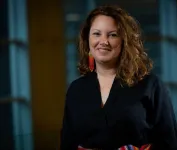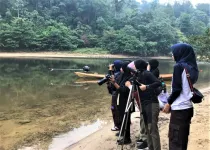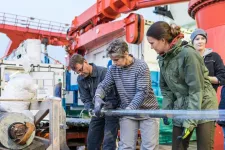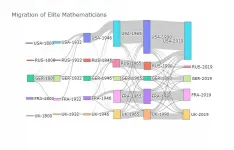Land-based learning reconnects Indigenous youth to their cultures, says Elizabeth Fast
A 4-day retreat emphasizing knowledge-sharing, survival skills, ceremony and inclusivity builds a sense of belonging
2021-03-30
(Press-News.org) Indigenous traditions often place land at the centre of their cultures. However, with more than half of Canada's Indigenous population now living in urban areas and Indigenous communities struggling to overcome legacies of colonialism defined by assimilation and land theft, that connection is getting frayed.
Elizabeth Fast, an associate professor of applied human sciences in the Faculty of Arts and Science, wanted to help Indigenous youth reconnect with their cultures in safe and accessible ways. Along with a youth advisory group composed of Indigenous youth (some of whom are also students), she has been organizing a series of land-based learning retreats revolving around Indigenous traditions and ceremonies.
The first, held in July 2018, is the subject of a new paper published in the International Journal of Indigenous Health.
"The youth participants found the retreat extremely nourishing," Fast says. "It provided many opportunities they've never had before to spend more time with Elders and Knowledge Holders to learn more about ceremonies and to connect with land-based learning. We explicitly created a cultural safety framework that welcomed different levels of connections with one's identity, including gender and sexuality."
The Restoring Our Roots project has since evolved into a five-year Land As Our Teacher participatory action research project exploring the ways land-based pedagogies benefit Indigenous youth.
Once-banned cultural practices now out in the open
Restoring Our Roots would not have been possible without input from the project's youth advisory committee, many of whom also participated in the program. By helping to develop the framework, pedagogical content, ethics and other aspects of the four-day retreat, they were able to come up with programming that was educational, culturally appropriate and inclusive.
Over the course of the retreat, the participants were mentored by Elders and worked with artists, community leaders, storytellers and other young people who guided them through activities meant to help them (re)connect to their Indigeneity. These included cultural workshops, arts-based activities, ceremonies, sweat lodges, medicines and storytelling sessions. All of it was centered around relationship with the land.
"Our ancestors grew up learning from and on the land. It was a way of life and still is for some," Fast says. "But for many Indigenous people, even those living in communities, it is less so because many of our cultural practices and ceremonies were banned. There is a real sense of loss and grief from losing those traditions. We were seeing a lot of interest in relearning and reclaiming them."
Land-based learning includes ways that Indigenous communities survive as peoples as well, such as hunting, fishing, gathering medicines, tanning hides and building fires and shelters, Fast explains.
Belonging for all
She adds that the retreat specifically made space for LGBTQ and Two-Spirit youth hoping to reconnect to their heritage -- a group often cut off or separated from their wider communities.
"Many of these youth have moved away from ceremony or accessing land-based learning because they might feel the impact of colonization around gender and sexual identity norms even more," she says. "If they feel they are going to experience transphobia or homophobia, they might just assimilate and move away from their cultures or communities."
Fast is now organizing a queer-only retreat for Indigenous youth this summer, despite the overall positivity and inclusion seen in past retreats.
"I think the sense of belonging is very important for Indigenous youth, especially for those who have felt disconnected for many reasons," she concludes. "It increases their courage to reconnect and can lead to some healing of intergenerational trauma. It also can be a foundation for deeper and better relationships with the land and help them get away from their technology-heavy lives to provide an experience many of them never had before."
INFORMATION:
[Attachments] See images for this press release:

ELSE PRESS RELEASES FROM THIS DATE:
2021-03-30
BOSTON - (March 25, 2021) - A mechanism has been identified that explains how physical exercise in pregnancy confers metabolic health benefits in offspring. According to researchers, the key lies with a protein called SOD3, vitamin D and adequate exercise, with the outcomes possibly forming the first steps to designing rational diet and exercise programs to use during pregnancy and particularly when mothers may also be overweight or obese.
The study, which was led by authors from the Joslin Diabetes Center at the Harvard Medical School and colleagues from Japan, the US, Canada and Denmark, has been published online by Cell Metabolism.
"We've known for a while that risks for obesity and type 2 diabetes can originate in the critical ...
2021-03-30
In a new study published in Conservation Science and Practice, researchers at the University of Maryland (UMD) partnered with Indonesian experts to explore the motivations and challenges of women pursuing a career in conservation sciences in Indonesia. Given that Indonesia is one of the most biodiverse countries on the planet but is simultaneously experiencing extreme rates of deforestation, it is an important target country for the conservation of global biodiversity. Conservation work remains male-dominated in Indonesia, especially fieldwork, so gaining a better understanding of the cultural norms and barriers in place for Indonesian women aspiring to a career in conservation represents an important step in supporting women ...
2021-03-30
Researchers from Newcastle University, UK, working with colleagues at King Mongkut's University of Technology Thonburi (KMUTT) in Thailand and the Institute of Urban Environment of the Chinese Academy of Sciences, analysed samples of water and sediment taken from aquaculture ponds and nearby canals at five locations in central Thailand's coastal region.
The research, which was part-funded by an institutional links grant awarded by the Newton Fund via the British Council, and which has been published in the Journal of Hazardous Materials, found that the highest prevalence of antimicrobial resistance (AMR) genes was in water ...
2021-03-30
Gas hydrates are a solid compound of gases and water that have an ice-like structure at low temperatures and high pressures. Compounds of methane and water, so-called methane hydrates, are found especially at many ocean margins - also in the Black Sea. In addition to a possible use as an energy source, methane hydrate deposits are being investigated for their stability, as they can dissolve with changes in temperature and pressure. In addition to releases of methane, this can also have an impact on submarine slope stability.
During a six-week expedition with the German research vessel METEOR in autumn 2017, a team from MARUM and GEOMAR investigated a methane hydrate deposit in the deep-sea fan of the Danube in the western Black Sea. During ...
2021-03-30
Most businesses were ill-prepared to deal with the pandemic and muddled though the challenges stemming from it, according to a report published today.
Resilience reimagined: a practical guide for organisations was produced by Cranfield University, in partnership with the National Preparedness Commission (NPC) and Deloitte. The report presents insights from business leaders from a range of sectors and makes seven recommendations for organisations on how to become more resilient, drawing on lessons from past 12 months.
Cranfield University's Professor David Denyer and Mike Sutliff conducted in-depth interviews and four focus groups with more than 50 C-suite level people (boards, senior executives, policymakers, and resilience directors) from FTSE 100 companies, ...
2021-03-30
As social media platforms like Instagram, Snapchat, TikTok and others continue to grow in popularity, adolescents are spending more of their time online navigating a complex virtual world.
New research suggests that these increased hours spent online may be associated with cyberbullying behaviors. According to a study by the University of Georgia, higher social media addiction scores, more hours spent online, and identifying as male significantly predicted cyberbullying perpetration in adolescents.
"There are some people who engage in cyberbullying online because of the anonymity and the fact that there's no retaliation," said Amanda Giordano, principal investigator of the study and associate professor in the UGA Mary Frances Early College of Education. "You have these ...
2021-03-30
Math's top prize, the Fields Medal, has succeeded in making mathematics more inclusive but still rewards elitism, according to a Dartmouth study.
Published in Nature's END ...
2021-03-30
Researchers at the Johns Hopkins Kimmel Cancer Center used machine learning techniques to detect mutational signatures in cancer patients. Their algorithm outperformed the current standard of analysis and revealed new mutational signatures associated with obesity, which is believed by cancer prevention experts to be becoming the most significant lifestyle factor contributing to cancer in the U.S. and most of the Western world.
The study was published in the Jan. 25 issue of the journal eLife.
"Mutational signatures are important in current cancer research as they enable you to see the signs left by underlying factors, such as aging, smoking, alcohol use, UV exposure, and BRCA inherited mutations that contribute to the development ...
2021-03-30
Making people fear the coronavirus may motivate us to wash our hands, keep our distance and wear a face mask. But fear also takes a heavy toll on our mental health and is fertile ground for discrimination and prejudice. New research shows a different path.
When the coronavirus pandemic hit the world in the spring of 2020, feelings of being capable or efficacious against the virus were a key factor in driving compliance with the authorities' guidelines. This is the result of a new study based on large surveys across eight Western democracies, published in British Journal of Health Psychology.
The extent to which we personally felt informed and capable of acting clearly affected the extent of our behaviour to prevent infection, e.g. by keeping our distance ...
2021-03-30
A team of researchers at the Technical University of Munich (TUM) has developed a new early warning system for vehicles that uses artificial intelligence to learn from thousands of real traffic situations. A study of the system was carried out in cooperation with the BMW Group. The results show that, if used in today's self-driving vehicles, it can warn seven seconds in advance against potentially critical situations that the cars cannot handle alone - with over 85% accuracy.
To make self-driving cars safe in the future, development efforts often rely on sophisticated models aimed at giving cars the ability to analyze the behavior of all traffic participants. But what happens if the models are not yet capable of handling some complex ...
LAST 30 PRESS RELEASES:
[Press-News.org] Land-based learning reconnects Indigenous youth to their cultures, says Elizabeth Fast
A 4-day retreat emphasizing knowledge-sharing, survival skills, ceremony and inclusivity builds a sense of belonging




